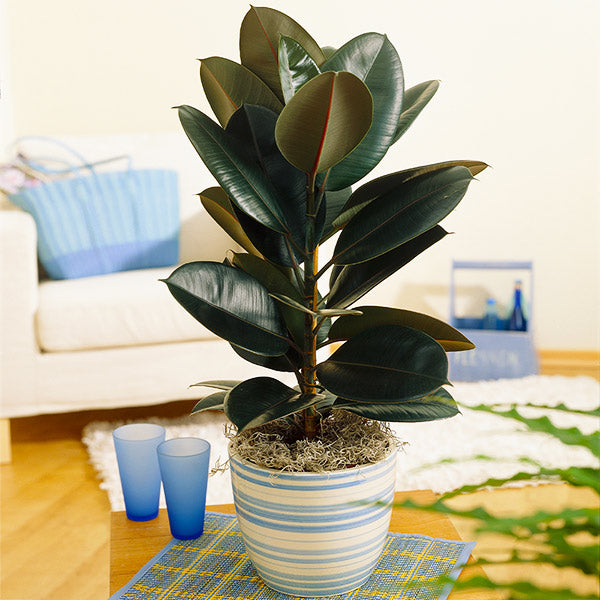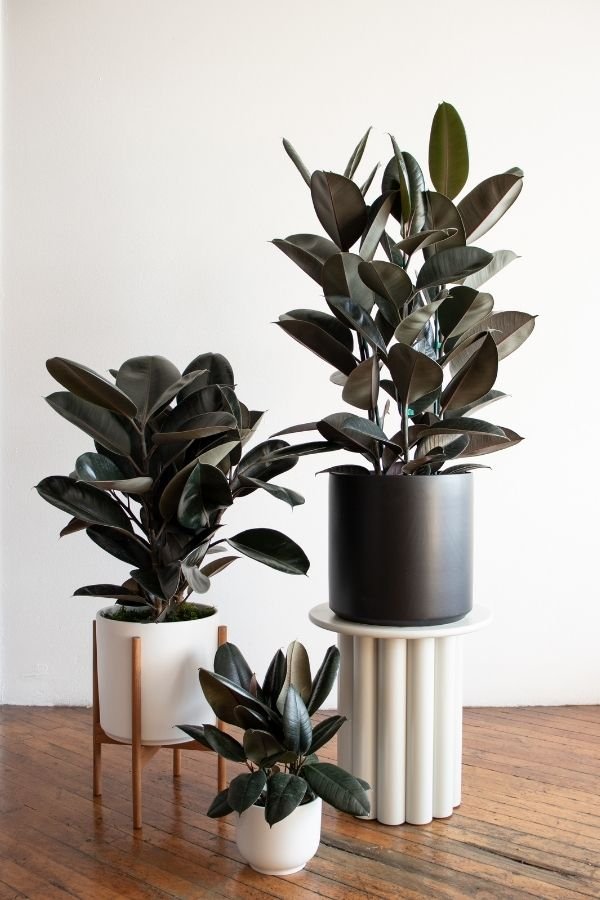With their large dark green leaves and tree-like growth habit, rubber plants are a great way to bring the tropics into your home. Although popular as ornamental plants, rubber plants are also rich in symbolism and meaning, especially in feng shui. In this article, we show you where to place rubber plants in your home for optimal care and energy flow.
Where to place rubber plants in the home – the essentials
Rubber plants are believed to increase luck, wealth and prosperity. In feng shui, these qualities are associated with the southeast corner of your home or room. Rubber plants are ideal for an office as they can also increase prosperity in your career, which is associated with the north.
About rubber plants

Also known as rubber figs or rubber trees, rubber plants (Ficus elastica) are members of the fig family (Moraceae). These plants are native to parts of Southeast Asia such as Bhutan, India and Indonesia. Rubber plants have also spread to Florida, Hawaii, Sri Lanka and parts of the West Indies.
These plants get their common name from the milky latex they produce, which was once used to make rubber. Rubber plants thrive in humid tropical rainforests, where they can grow up to 130 feet tall. As a rubber tree grows, it uses aerial roots to stabilize itself in the soil. In India, rubber trees are trained to create organic bridges.
Rubber plants have dark green oval foliage. The rounded leaves have a thick, almost leathery texture and a glossy finish. When young leaves emerge, they are protected by a fleshy “sheath” that falls away when the new leaf is ready to unfold.
Rubber plants are extremely popular as ornamentals. They have low maintenance requirements and provide several benefits, including purifying the air, increasing productivity and improving memory. Additionally, rubber plants come in several varieties, including ‘Robusta’ and some variegated varieties.
Rubber plants and Feng Shui

Rubber plants also bring a range of feng shui benefits to your home. These low-maintenance plants are associated with happiness, prosperity and wealth. This means that rubber plants are ideal feng shui plants for your home office if you need to increase your productivity and success.
Like all houseplants, rubber plants are strongly connected to the wood element in feng shui. The Five Elements Theory, also known as Wu Xing, is an important discipline in feng shui. It focuses on the properties and relationships of five elements; earth, fire, metal, water and wood.
The wood element represents growth, originality, rejuvenation, spirituality and trust. The wood element is also associated with desirable factors such as health and prosperity.
Where to place rubber plants in the home

According to the Bagua map
Feng shui is an ancient Chinese philosophy that focuses on the quality of the energies that flow through our home. Practitioners can influence and harmonize these energies by choosing the colors and objects used in each room. This is done using the Bagua map, which is divided into nine areas:
- Center = Health (Tai Qi)
- North = Career (Kan)
- Northeast = Knowledge (Gen)
- East = Family (Zhen)
- Southeast = prosperity and wealth (Xun)
- South = fame and reputation (Li)
- Southwest = Relations (Only)
- West = children and creativity (Dui)
- Northwest = Travel and helpful people (Qian)
Rubber plants are associated with happiness, prosperity, success and wealth. These attributes are governed by the southeast part of the Bagua map. So place rubber plants in a southeast location to increase your wealth.
Rubber plants are ideal feng shui plants for a home office. Not only can they promote prosperity and success, but they can also increase yang energy. Yang energy is active and busy, which is exactly the kind of environment you want when trying to work from home.
The eastern and southeastern parts of the Bagua map are connected to the wood element. Live plants are ideal additions if you are trying to grow the wood element. The eastern part of the Bagua map is associated with family, so rubber plants are a great addition to family spaces.
Feng shui is as much about texture and feel as it is about elements. Sharp corners or objects are believed to add negative, attacking energy that you do not want in your home. Rubber plants have soft, rounded foliage that helps disperse negative energy in areas with many sharp corners.
The best places for rubber plants based on their care needs

Rubber plants require bright indirect light to thrive, although they can tolerate some shade. East or southeast windows are ideal because they get sun in the morning when it is less intense. These locations tie in nicely with the best locations for rubber plants, according to the Bagua map.
Rubber plants also require warm temperatures and moderate humidity. Rubber plants should be located somewhere with stable temperatures from 60 to 75ºF. Avoid places with dry, cold or hot drafts from air vents and radiators.
Where NOT to place rubber plants in the home

As mentioned earlier, the five element theory of feng shui looks at the interconnected relationship
between the five main elements. These interactions are not always positive – some elements can weaken or collide with others, creating negative energy. Rubber plants are associated with the wood element, which makes them vulnerable to certain other elements.
Fire weakens wood because fire consumes and burns wood in nature. In the Bagua map, fire is connected to the south, which rules fame and reputation. If rubber plants are placed anywhere in connection with the fire element, their ability to increase prosperity and success may be impaired.
Wood is also vulnerable to the metal element, and the two are seen to clash in feng shui. Metal is associated with the west and northwest Bagua map. Areas on the Bagua map connected to metal are not suitable for rubber plants because metal cuts through wood in nature.
Rubber plants are good for rooms that need yang energy. But they don’t necessarily work for areas that should have yin energy. Yin energy is soothing and restful, which is desirable in a bedroom. Avoid placing rubber plants in your bedroom to promote more yin energy.
Where to place rubber plants outdoors
In some areas of the United States, rubber plants can be grown outdoors in gardens or patios. As tropical plants, rubber plants are best suited to USDA growing zones 10 through 12. In other areas, rubber plants are best grown in pots and placed outside during the summer. But when winter comes, protect them indoors.
Rubber plants do best in an outdoor space that receives bright, indirect morning sunlight and partial shade the rest of the day. These plants also prefer a warm, moist environment protected from strong winds. Outdoor rubber plants should be watered if the top inch of the growing medium is dry.
Essential rubber plant care

Rubber plants are incredibly hardy houseplants but have enough dramatic foliage to appeal to beginners. Rubber plants prefer bright, indirect sunlight from east- or southeast-facing windows. They tolerate periods of shade.
Rubber plants don’t drink much and usually require water every week or so during the spring and summer. If the top inch or two of soil feels dry, give them a drink. To prevent root rot and overwatering, rubber plants need well-draining soil. A 1:1:1 mix of standard potting mix, pine bark and perlite or sand should do the trick.
These tropical houseplants prefer consistent warmth and humidity. Ideal temperatures for rubber plants range from 60 to 75ºF with moderate humidity levels. If you feel comfortable, chances are your rubber plant will too. Mist the leaves or use a humidifier or stone tray to increase humidity if needed.
Rubber plants should be replanted once every year or two in the spring. Rubber plants can be propagated by cuttings, which should be kept warm and moist until established. Fertilize rubber plants every four to six weeks during the growing season, but stop in the winter.
Frequently asked questions about where to place rubber plants
Rooms with east or southeast facing windows are best for rubber plants. In terms of feng shui, rubber plants provide the most benefit in home offices.
For east or southeast facing windows, rubber plants can be placed about three feet away. If the window faces south or southwest, they should be placed farther away—preferably eight to ten feet.
Rubber plants have an upright, bushy growth habit that makes them ideal for unused corners. This also helps soften the sharp edges and negative energy in those corners.
Although rubber plants can tolerate full shade for short periods, they prefer bright, indirect sunlight whenever possible. Partial shade is also a good option in connection with a little morning sun.
Although rubber plants are hardy, cold or dry drafts can be a problem. Keep rubber plants away from air vents or radiators or they will dry out too much.
Where to place rubber plants – the final word
Rubber plants are robust, beautiful and versatile houseplants. When placed in southeast locations, rubber plants can promote happiness, prosperity, wealth and success. This also makes rubber plants ideal in a home office. Rubber plants can also help mitigate the negative energy in areas with many sharp corners.
If you’re looking for your next Rubber Tree Plant to add to your collection, see our in-depth guide to the best plant shops that supply Rubber Tree Plants across the country.


:max_bytes(150000):strip_icc()/grow-rubber-plant-ficus-indoors-1902755-02-700e0cea38e14a8987348973fb193f29.jpg)
:max_bytes(150000):strip_icc()/grow-rubber-plant-ficus-indoors-1902755--01-01-196969b3635e435b9d3b623d3d5a732f.jpg)









